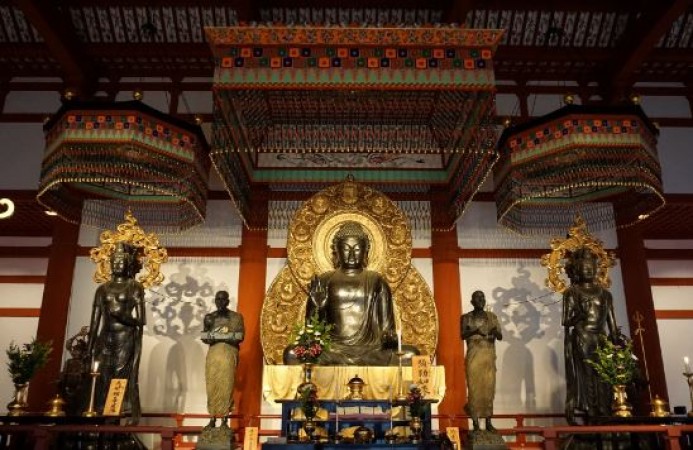
Nara was Japan’s first capital from 710 to 784, and during this time Buddism had a strong influence on politics especially the Imperial Family. The Imperial Family or the influential Fujiwara family built Todaiji and many Nara temples. Among the many temples, the best well known are Nanto Shichi Daiji (The Seven Great Temples) and the Historic Monuments of Ancient Nara. Buddhism flourished in Japan and gradually gained devotees.
During the Nara period, many Buddhist temples were built in the capital which received imperial patronage. Among these, seven temples were the most influential.
Yakushi-ji
It is a renowned Buddhist temple located in Nara, Japan. It is one of the oldest and most historically significant temples in the country. Yakushi-ji was established in the early 7th century during the Nara period and was founded by Emperor Tenmu in 680 AD to pray for the recovery of his ailing Empress Jito. It was named after Yakushi Nyorai, the Buddha of healing and medicine.
Also Read: Kotoku-In Temple: A Serene Sanctuary of Peace in Japan
Todai-ji
It is a famous Buddhist temple located in Nara, Japan. It is one of the most significant and historically important temples in the country and holds great cultural and religious significance. Todai-ji is renowned for its massive bronze Buddha statue, which is one of the largest bronze statues of Buddha in the world.
Also Read: Kinkaku-ji Temple: A Glorious Jewel of Japan's Golden History
Saidai-ji
It is also known as Saidai-ji Temple, is a prominent Buddhist temple located in Nara, Japan. It is officially called "Saidai-ji Kannon-in Temple" and is one of the significant temples in the city of Nara, which was Japan's capital during the Nara period (710-794 AD). The "Great Western Temple" is a Buddhist temple that was the powerful Seven Great Temple in the city Nara.
Also Read: White Horse Temple: A Historical and Cultural Icon of China
Kofuku-ji
Kofuku-ji is another significant Buddhist temple located in the city of Nara, Japan. Like Saidai-ji, Kofuku-ji is also a historic temple with deep roots in Japanese Buddhism and dates back to the Nara period (710-794 AD). It is one of the most important temples in Nara and a UNESCO World Heritage Site. Kofuku-ji was originally founded in 669 AD by Kagami no Okimi, the wife of Fujiwara no Kamatari, who was a powerful statesman during the Asuka period. The temple served as a symbol of the Fujiwara clan's wealth and influence in ancient Japan.
Also Read: Famen Temple: A Journey through Time and Spirit
Horyu-ji
Horyu-ji, also known as Horyuji Temple, is a historic Buddhist temple located in Ikaruga, Nara Prefecture, Japan. It is renowned for being one of the oldest and most significant wooden structures in the world. Horyu-ji was founded in 607 AD by Prince Shotoku, a regent and statesman who played a crucial role in the early spread of Buddhism in Japan. The temple was constructed under the patronage of Prince Shotoku to promote Buddhist teachings and serve as a center for religious and cultural activities during the Asuka period (592-710 AD), which predates the Nara period. Horyu-ji was designed as a monastic complex, housing monks and students of Buddhism.
Also Read: Maya Devi Temple, Lumbini: Discovering the Sacred Birthplace of Lord Buddha
Gango-ji
Gango-ji, also known as Gangoji Temple, is a historic Buddhist temple located in Nara, Japan. It is one of the Seven Great Temples of Nara and holds immense cultural and historical significance. The temple was established in the Asuka period, making it one of the oldest temples in Japan. It was founded in the early 6th century, around 588 AD. Gango-ji was originally constructed under the name "Asuka-dera" and later relocated to its current site in Nara during the Nara period (710-794 AD). The temple was moved to Nara at the same time as the capital, and it played an essential role in the promotion and spread of Buddhism in the country.
Also Read: Pashupatinath Temple: Nepal's Spiritual and Cultural Gem
Daian-ji
Daian-ji, also known as Daianji Temple, is a historic Buddhist temple located in Nara, Japan. It is one of the Seven Great Temples of Nara and holds significant cultural and religious importance in Japanese history. The temple was founded during the Asuka period in the early 8th century, around 728 AD. Daian-ji was established by Emperor Shomu in memory of his mother, Empress Gensho, who was Japan's first reigning empress. The temple was constructed as a place of prayer for her soul and to promote Buddhist teachings in the region.
Also Read: From Bangalore to Pondicherry, Here Are Seven Places to Visit in Tamil Nadu
Hollywood Sikh Temple: Promoting Interfaith Dialogue and Understanding